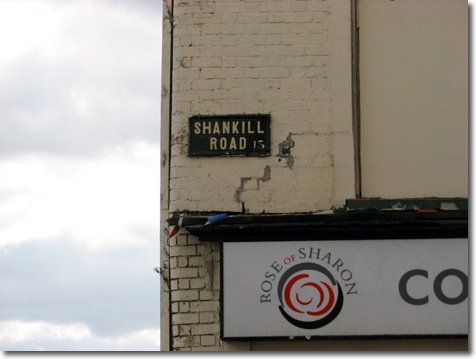
A terrible beauty
Belfast, Northern Ireland - Wednesday, April 21, 2010 by: Michael Townsend
I steal this phrase from William Butler Yeats, “ Easter 1916”, but find nothing else to describe what I felt that Sunday as I wandered the streets in Belfast in search of an understanding of a not too distant past.
The murals I saw spoke of a passion and a willingness to fight and die for a cause that I might never comprehend. The murals were predominately Ulster Loyalist but some including the one of Bobby Sands were Irish Republican Army. The Protestant murals had a serious belligerent spirit where the Catholic murals seemed more political and reverential. The first ones presented here were from South Belfast and I was reminded very clearly of where I was and who lived in this zone.
I then walked to the west of Belfast through another Protestant quarter and then to the fence and the gates to a Catholic neighbourhood. I walked up Shankill Road to an intersection with a terrible history. Gunman would wait here. If a car traveling on the road went straight and the killers were IRA, they would open up on the car, as it would be traveling into the Protestant area. If a car turned left and those with the guns were Loyalists they would open up on the vehicle, as they would be heading for a Catholic district. No provision was made for who might be in the car, none at all, by either side. And then I came across ‘The Wall’. This was the partition between the Protestant and Catholic neighbourhoods in this west Belfast region, which was connected by ‘the gate’. It is my understanding the gate is still closed at night but no confirmation on that. There was very little traffic passing through this gate, either cars or people on foot, so I was very much alone with my camera. The contrast between the two sides was very clear. I was passing from a sector with a strong confrontational nature to a neighbourhood remembering a sad and horrific past. In this Catholic neighbourhood, I found carefully tended memorials to martyrs of a cause thoroughly believed in, men and women who had fought and died but would live on in lasting memory.
I then came across the Catholic murals. These would not glorify the battle but revere the fallen and adhere the political nature of their fight with struggles occurring around the world. This was something I had not expected.
The last pictures I include show two interesting buildings. The tall red building, now a student housing development, was once home to British Security forces, deep in a Catholic area. It would loom large in this community and was intended to provide a clear view of the Catholic sector. The last picture is the courthouse. Here was a building, with nothing to reveal to a visitor what it was, that had its first two floors bomb resistant and the rest exhibiting the extreme secure nature of the whole facility. When one is prosecuting martyrs, defense is paramount.
Among other things, the day would leave me with this thought. When one tries to understand something that is seemingly incomprehensible; the past can be revealed by how the participants choose to remember it. The fighting nature depicted in the imagery of the murals in one community were in stark contrast to the special reverence held for individuals who laid down their lives for a community in peril. Oppressor and oppressed became clearer to me. Assurance that I am right remains uncertain.